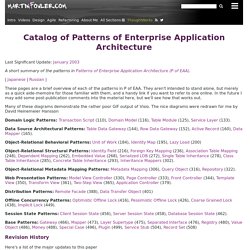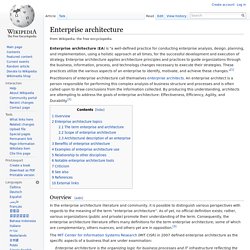

Catalog of Patterns of Enterprise Application Architecture. Last Significant Update: January 2003 A short summary of the patterns in Patterns of Enterprise Application Architecture (P of EAA). | Japanese | Russian | These pages are a brief overview of each of the patterns in P of EAA.

They aren't intended to stand alone, but merely as a quick aide-memoire for those familiar with them, and a handy link if you want to refer to one online. In the future I may add some post-publication comments into the material here, but we'll see how that works out. Many of these diagrams demonstrate the rather poor GIF output of Visio. Domain Logic Patterns: Transaction Script (110), Domain Model (116), Table Module (125), Service Layer (133). Data Source Architectural Patterns: Table Data Gateway (144), Row Data Gateway (152), Active Record (160), Data Mapper (165). Object-Relational Behavioral Patterns: Unit of Work (184), Identity Map (195), Lazy Load (200) Object-Relational Metadata Mapping Patterns: Metadata Mapping (306), Query Object (316), Repository (322). Institute For Enterprise Architecture Developments.
Describing the Enterprise Architectural Space. Patterns & practices Developer Center Authors: David Trowbridge, Ward Cunningham, Matt Evans, Larry Brader, Microsoft Platform Architecture Guidance; Paul Slater, Wadeware.

Microsoft Corporation June 2004 Summary: This document presents an organizing table that describes the enterprise architectural space, shows relationships among artifacts in the space, and demonstrates how different roles in your enterprise view enterprise architecture. This document also demonstrates how pattern authors can use the organizing table to organize existing patterns and to identify areas where patterns are not currently documented. Contents IntroductionEnterprise Architectural Space Organizing TableUsing the Organizing TableConclusionReferencesContributorsKey to Pattern Names in Figure 4 Introduction Effective organization is critical to help us gain a full understanding of the complex world surrounding us. Enterprise-level software and system architecture are ripe for a similar organizing system. Figure 1. Enterprise architecture CIO. Law Firm CIO Makes the Case for Microsoft Lync Mon, April 07, 2014 - Law firm Holland & Knight already had a who's who of best-of-breed communications products deployed when the firm's IT team decided it needed to replace the tangled mess of PBX systems that provided voice lines at its many offices.

It chose to jettison them all in favor of an infrastructure built on Microsoft Lync Server 2013. Full Story » U.S. Spy Agencies Adopt New IT Approach Fri, March 07, 2014 - The CIA's decision to use Amazon's cloud is part of a broader IT shake-up to make the spy business more efficient. Facebook Open Sources Thrift Protocol ... Thu, February 20, 2014 - After more than six years of internal development of its branch of the cross-language framework that powers its internal services, Facebook has released that branch to open source and hopes to work with the Apache Thrift community to incorporate the work. HP Rolls Out Services to Improve Data Center Efficiency Where Do SDNs Fit in the Data Center? Enterprise architecture. Enterprise architecture (EA) is "a well-defined practice for conducting enterprise analysis, design, planning, and implementation, using a holistic approach at all times, for the successful development and execution of strategy.

Enterprise architecture applies architecture principles and practices to guide organizations through the business, information, process, and technology changes necessary to execute their strategies. These practices utilize the various aspects of an enterprise to identify, motivate, and achieve these changes. "[1] Practitioners of enterprise architecture call themselves enterprise architects. Overview[edit] In the enterprise architecture literature and community, it is possible to distinguish various perspectives with regards to the meaning of the term “enterprise architecture”. The MIT Center for Information Systems Research (MIT CISR) in 2007 defined enterprise architecture as the specific aspects of a business that are under examination: Criticism[edit] Enterprise Architecture.